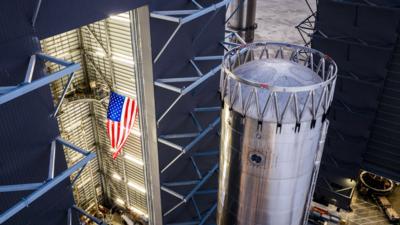Wed, Nov 26, 2025
Booster 18 Experienced a Major Structural Failure During Initial Tests
A day after its Starship Version 3 booster experienced an abrupt structural failure, SpaceX took to social media to share that it was both a blessing and a curse that the incident happened so early into testing. Engines had yet to be installed, no propellant was on board, and all personnel were stationed safely away from the facility.

“Booster 18 suffered an anomaly during gas system pressure testing that we were conducting in advance of structural proof testing,” SpaceX’s statement read. “The teams need time to investigate before we are confident of the cause. No one was injured as we maintain a safe distance for personnel during this type of testing. The site remains clear and we are working plans to safely reenter the site.”
Just after 4:00 am on its first night of gas-system pressure tests at the company’s Massey facility in Starbase, Texas, the booster’s lower section crumpled inward around the liquid oxygen tank. Photos from observers later in the morning revealed widespread deformation along the vehicle’s base. The immediate verdict was that Booster 18 is almost certainly a total loss.
The timing makes the setback sting a bit more. Booster 18 had only rolled out a day earlier and represented the debut hardware of the long-anticipated Starship V3 line. It aimed to address structural and reliability shortcomings found in previous boosters, with improvements centering on enabling more frequent flights, shorter downtime between reuse, and tower-catch recovery. Elon Musk has even publicly positioned the V3 series as a step toward Mars.

Safe to say that it won’t be getting there anytime soon… especially with the booster’s campaign screeching to a halt before sunrise. If there’s a silver lining, however, it’s that the damage appears confined largely to the booster itself. The incident did not share the fire or infrastructure destruction with June’s upper-stage explosion at the same test site.
Still, SpaceX is operating on an already ambitious timeline. The company needs Starship flying regularly and reliably to support booster landings, Starlink deployment flights, and NASA’s near-term Artemis obligations. Those include an on-orbit refueling demonstration scheduled for late 2026 and crewed lunar support in 2027.
More News
Also: 1st-Ever Space Crime Was a Fraud, IAE Buys Diamonds, Kennon Bows Out, Perseverance Rover An interesting moment came about this past Sunday as ANN CEO, Jim Campbell, noted tha>[...]
Have A Story That NEEDS To Be Featured On Aero-News? Here’s How To Submit A Story To Our Team Some of the greatest new stories ANN has ever covered have been submitted by our>[...]
From 2023 (YouTube Edition): Deviation from the Historical Mean Racine, Wisconsin-based DeltaHawk is a privately-held manufacturer of reciprocating engines for aircraft and hybrid >[...]
Smoke Began Entering The Cockpit During The Landing Flare, And Then The Pilot Noticed Flames On The Right Side Of The Airplane Analysis: The pilot reported that about 30 minutes in>[...]
Remote Communications Outlet (RCO) An unmanned communications facility remotely controlled by air traffic personnel. RCOs serve FSSs. Remote Transmitter/Receivers (RTR) serve termi>[...]
 Airborne 11.24.25: ANN's 30th!, Starships V3 Booster Boom, Earhart Records
Airborne 11.24.25: ANN's 30th!, Starships V3 Booster Boom, Earhart Records ANN FAQ: Submit a News Story!
ANN FAQ: Submit a News Story! Classic Aero-TV: DeltaHawk Aero Engine Defies Convention
Classic Aero-TV: DeltaHawk Aero Engine Defies Convention NTSB Final Report: Glasair GlaStar
NTSB Final Report: Glasair GlaStar ANN's Daily Aero-Term (11.22.25): Remote Communications Outlet (RCO)
ANN's Daily Aero-Term (11.22.25): Remote Communications Outlet (RCO)




